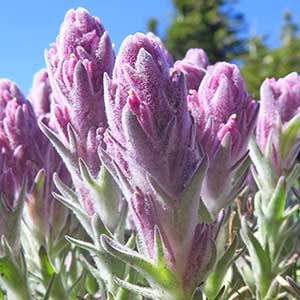Castilleja lineariloba
Castilleja schizotricha
pale owl-clover, thin-lobed owl's clover
split hair Indian paintbrush, split-hair paintbrush
solitary or few, erect, unbranched or branched, hairs spreading, short to long, ± stiff, mixed with short stipitate-glandular ones.
few to many, ascending to erect, unbranched, hairs dense, appressed-ascending, matted, long, soft, branched, eglandular, ± white-woolly, obscuring surface.
green, linear to narrowly lanceolate or narrowly oblong, 2–5.7 cm, not fleshy, margins plane, flat, 3–7(–9)-lobed, apex acuminate to acute;
lobes spreading to ascending, linear to narrowly oblong, apex acuminate.
gray-green with hairs, surface green to purple, linear-lanceolate, 0.5–2 cm, not fleshy, margins plane, ± involute, 0(–3)-lobed, apex acute to acuminate, sometimes rounded;
lobes sometimes divergent, spreading-ascending, narrowly linear, apex acute.
2–14 × 1–4 cm;
bracts greenish throughout, or proximally greenish, distally white, cream, pale pink, or pale purple on apices, linear-lanceolate, 5–7(–9)-lobed, sometimes with secondary lobes;
lobes ascending to spreading, linear to narrowly oblanceolate, long, arising all along leaf axis, apex acute to obtuse.
3–8 × 1–2 cm;
bracts purple, lavender, pinkish, or dusty red throughout, sometimes greenish throughout or proximally greenish, distally colored as above, obscured by hairs, lanceolate, 3(–5)-lobed;
lobes ascending to erect, linear to oblanceolate, short, arising near or above mid length, apex obtuse.
straight or slightly curved, 12–25 mm;
tube 9–14 mm, expanded distally;
abaxial lip sometimes slightly exserted, never hidden by slender calyx lobes, beak exserted;
beak straight, adaxially white or lilac pink, 3–5.5 mm, inconspicuously puberulent;
abaxial lip proximally white, distally yellow, with purple or red-brown spots, conspicuous, pouches 3, inflated, 4–6 mm, 4–5 mm wide, 2 mm deep, longer than deep, 1.5–4 mm, 90% as long as beak;
teeth erect, white, usually with purple spot at base, 0.5–1 mm.
straight, 15–20 mm;
tube 8–9 mm;
beak included to slightly exserted, adaxially purple or pink, 3.9–5 mm, densely puberulent with white, woolly hairs;
abaxial lip deep purple, inconspicuous, pouched, pouches shallow, 3–5 mm, 80–100% as long as beak;
teeth upright-ascending, reduced, appearing white, 1.5–2 mm.
colored as bracts, 15–25 mm; all 4 clefts subequal, 7–11 mm, 50–67% of calyx length;
lobes linear, apices often slightly expanded, apex obtuse to acute.
colored as bracts, 11–18 mm;
abaxial and adaxial clefts 3.5–6 mm, 33–50% of calyx length, all 4 clefts subequal, lateral 4–6 mm, 33–50% of calyx length;
lobes linear, apex acute.
glabrous.
= 20.
Castilleja lineariloba
Castilleja schizotricha
Castilleja lineariloba is endemic to the western slope of the Sierra Nevada. Its chromosome number is 2n = 20, an apparent aneuploid reduction and documented by numerous counts. This diploid number is shared only with two very distantly related annual species endemic to central Mexico, C. gracilis Bentham and C. tenuifolia M. Martens & Galeotti.
(Discussion copyrighted by Flora of North America; reprinted with permission.)
Castilleja schizotricha is a rare species restricted to high elevations in the mountains in Siskiyou and Trinity counties in northwestern California and in Jackson and western Klamath counties in southwestern Oregon. See the discussion of 6. C. arachnoidea for morphological differences between it and C. schizotricha, as the two are sometimes confused. Though their ranges overlap, they do not appear to hybridize.
(Discussion copyrighted by Flora of North America; reprinted with permission.)
- Local floras:
CA
- Local Web sites:
CalFlora,
CalPhotos
WildflowerSearch
iNaturalist (observations)
- LBJ Wildflower Center
- SEINet
- Plants of the World Online
- Encyclopedia of Life
- Wikipedia
- Google Image Search


